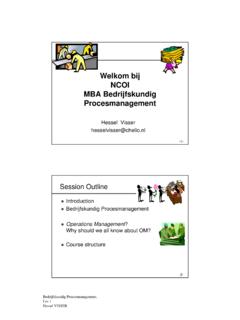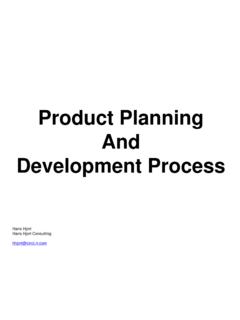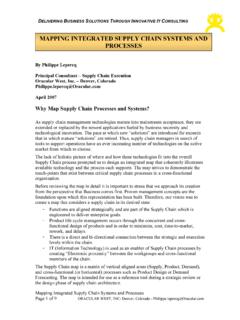Transcription of Business Process Management - Six Sigma Qualtec
1 Six SigmaQualtecBusiness Process Management is an enterprise-wide,structured approach to providing the products and servicesyour customers value understanding the key Business processes your company uses to meet these needs, the gap betweencustomer expectations and your ability to perform begins to emerge. Processes that are inefficient or ineffectivein delivering what customers require are clearly identified and targeted for improvement. As the entire organizationbegins to measure performance in terms of critical, customer-driven requirements, employees no longer thinkof themselves as functional managers responsible for functional outputs. Instead, they see their roles in thecontext of a greater, more important goal -- satisfying and creating loyal customers.
2 As Process thinkers, theyconsider the potential impact of their actions and decisions upstream and downstream and ultimately on thecompany s ability to deliver what it promises its customers. Onevision, one purpose, and a meaningful way to measure everyone s progress. Business Process Managementtransforms reactive organizations into innovative leaders with the speed and agility to anticipate change beforethe market demands change. Business Process ManagementAchieving Strategic Alignment and Performing to an Executive Dashboard Business Process ManagementAchieving Strategic Alignment and Performing to an Executive Dashboard PROCESSIMPROVEMENTESTABLISHSTRATEGICVISI ONKEYBUSINESSPROCESSESPROCESSMETRICSYOUR DESIRED Business RESULTSCUSTOMERNEEDSCUSTOMERSATISFACTION FUNCTIONSBUSINESS PROCESSBUSINESS PROCESSES ARE CROSS-FUNCTIONALBPM focuses a company s objectives and improvements on it s most importantprocesses aligning them with an organization s strategy and Process Management provides the most effective and efficient way to drive Process an understanding, measurement, and analysis of your operational processes.
3 BPM aligns yourorganization s direction and objectives with the customer s needs. It is important to understand thatthese are not typical functional processes that are contained within a functional silo alone, but are linkedcross-functionally, moving horizontally across the organization s functions. These are considered the Key Business Processes (KBPs).All too often companies establish effective goals, strategies and objectives but lack the mechanismsto identify and drive improvement efforts with a Process focus as opposed to a functional approach,which is siloed and far less-effective. Business Process Management (BPM) provides precisely theprocess focus that organizations need in order to achieve the disciplined design and careful executionof their end-to-end Business processes.
4 Designed to cascade through an organization, BPMfocuses a company s objectives and improvements on the most important processes, especiallythose that require contributions from multiple functions within the organization. BPM culminates inthe alignment of the organization s vision, mission, strategies, and objectives to satisfy customerrequirements and profitably enhance the customer Process ManagementSix Sigma QualtecAn effective Business model begins with the Voice-of-the-Customer (VOC) objectives the understanding of yourcustomer s desired Business results and what thatcustomer is trying to achieve. By translating thosecustomer needs into what you can do as an organizationto profitably fulfill them, you can create your own Voice-of-the- Business (VOB) objectives and Critical SuccessFactors.
5 In order to achieve both the VOC and VOBobjectives, you must address both the behavioral andtechnical sides of performance improvement. Thusbusiness performance improvement must include bothleadership involvement and education as well as processmanagement THECUSTOMER YOURDESIREDBUSINESSRESULT SKEYBUSINESSPROCESSESBUSINESSPROCESSMANA GEMENTWith BPM your company can collaboratively and quickly define itsKey Business Processes (KBPs). Once you have identified yourKBPs, the proven methodology of BPM enables you to: Identify from a KBP perspective where improvements will have the greatest measurableeffect on the Business and assign clear owners to the KBPs Agree on Process performance metrics that directly tie to the organization s objectivesand critical success factors Create Process improvement charters with clearly defined Business cases Select the right people, tools, and skill-sets to successfully meet the objectives ofevery chartered project Measure, manage, and share the Process improvement accomplishments across the organization to create a self-sustaining progression of Process -focused improvements Foster a culture in which people understand the importance of a Process -focusedenterprise, know how data can be used to drive change.
6 And do what they canindividually to identify and achieve the most significant Process improvementopportunities within their purviewAN EFFECTIVE Business MODEL2 2006 Six Sigma QualtecBusiness Process ManagementAchieving Strategic Alignment and Performing to an Executive Dashboard Business Process Management OverviewThere are three levels of BPM. The highest order of the methodology is called BPM Strategic; thenext level is Process Owner, and the third is Team Member or Yellow Belt (for operationally-focusedactivities). Through a series of carefully structured and sequenced workshops, BPM can be efficientlyand effectively cascaded down through the organization from strategic leaders through processowners to team members. BPM provides the most effective and efficient tool available to bridge the gap between a functionalmentality and a Process perspective.
7 But first let s take a look at how your organization s goals andobjectives should be developed with Critical Success Factors in Process PERSPECTIVEC ritical Success Factors (CSF) are the ingredients for successthat need to be achieved and measured by your these are the marching orders that get communicatedthroughout the organisation, your organisation s goals andobjectives should be developed with these CSFs in mind. Youmust measure CSFs to gauge their success, as these successmetrics then make up the Executive Dashboard or Scorecardthat you will use to monitor and motivate the success metrics have been set,Key BusinessProcesses (KBP) are identified; Process owners are established,and Process metrics are developed. In many cases, theprocess metrics include a mix of existing and new the same session in which KBPs are identified,youalso identify enabling processes those processes, likeInformation Services, Purchasing, and Human Resources, thatare required to enable or support identification of Key and Enabling processes provides an additional benefit to participants in the workshop the ability to recognizethese processes as cross-functional in nature rather than as bounded by a functional silo mentality is what differentiates atrue BPM implementation from an exercise that is nothing more than creating a list of departmental activities, responsibilities, andmeasures.
8 Most organizations think in this functional manner, which results in the sub-optimization of many of the selected performanceimprovement activities because the improvements don t transcend departmental boundaries. Often these activities are unrelated tocorporate objectives and focus instead on specific departmental or functional objectives and goals. By directly addressing this coredeficiency in corporate Process thinking, BPM provides the most effective and efficient tool available to bridge the gap between afunctional mentality and a Process intent is not to create a new organizational structure but to assign responsibility for the activities that take place across theorganization as they relate to KBPs. Hence the word ownership connotes a tangible responsibility: An individual owns the results andcoordination of activities within that KBP and is accountable regardless of the number of functions that contribute to the Process .
9 It isthis ownership and a clearly defined metrics system tied to the Voice of the Customer, the Voice of the Business , and the CriticalSuccess Factors that consistently produces Sigma QualtecThe Three Levels of BPM MethodologyThrough this series of carefully structured and sequenced workshops, starting with the strategicworkshop, BPM can be efficiently and effectively cascaded down through the organization from strategic leaders through Process owners and down to team members or yellow Process accountability, combined with Process metrics drive customer satisfactionand deliver top Business OF THE CUSTOMERSTRATEGICVISIONPROCESSOWNERPROCE SSTEAMMEMBERSIX Sigma ROLESCHAMPIONMASTER BLACK BELTSBLACK BELTSGREEN BELTSYELLOW BELTSB usiness Process Management3 Process Management Improvement and Design encompasses the tools and methodologies for improvementsuch as Six Sigma DMAIC (Black Belt, Green Belt, and Yellow Belt), Lean, Design for Six Sigma (DFSS),and Problem-Solving, to name a few.
10 Leading with BPM is the most efficient and effective way to firstidentify and prioritize the most significant improvement opportunities, which can then be used to generatewell-defined improvement project charters. During the Process of creating project charters the appropriatetools and skill-sets to accomplish the project objectives are also chosen. In simple terms, you identify themost valuable potential improvements and select the right tools to facilitate each improvement. 4 2006 Six Sigma QualtecBusiness Process ManagementAchieving Strategic Alignment and Performing to an Executive Dashboard INITIALLEVEL 1 DISCIPLINEDPROCESSCONSISTENTPROCESSPREDI CTABLEPROCESSOPTIMIZEDPROCESS Processes not documents Indicators not in place Process performance inconsistent Success depends onindividual eff orts and heroics LEVEL 2 LEVEL 3 Process flowcharts in place Indicators and improvement opportunities identified Indicators linked to needs of next Process customer Regular, rel iable data reporting Core processes are standardized and integrated Supervisors use Process Management systems Operational performance and cost are primary focusLEVEL 4 Upstreamprevention in place Using Statistical Process Control (SPC)







